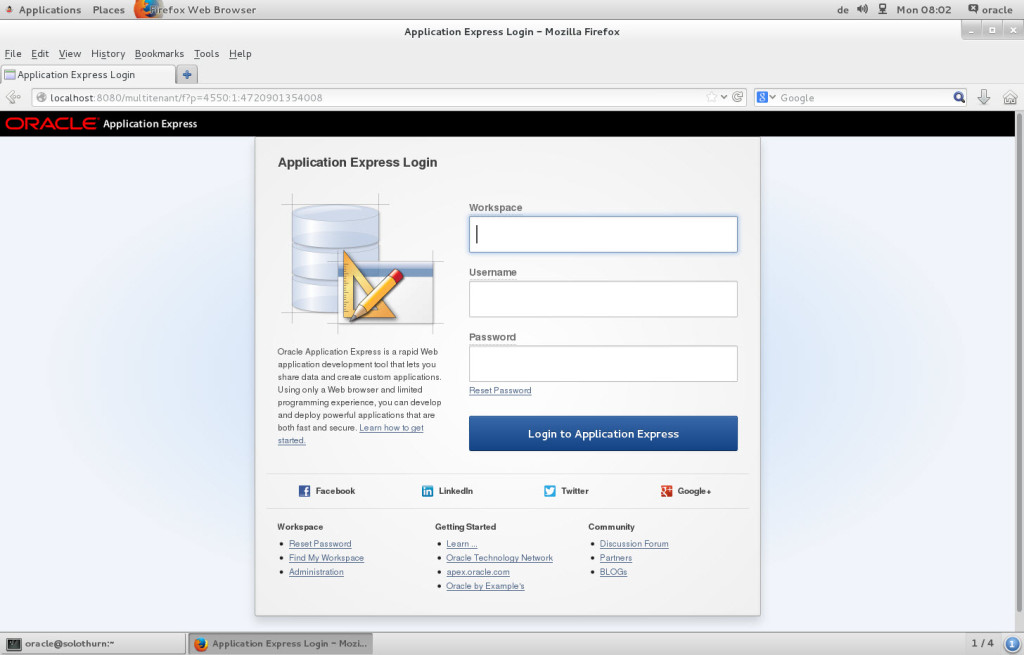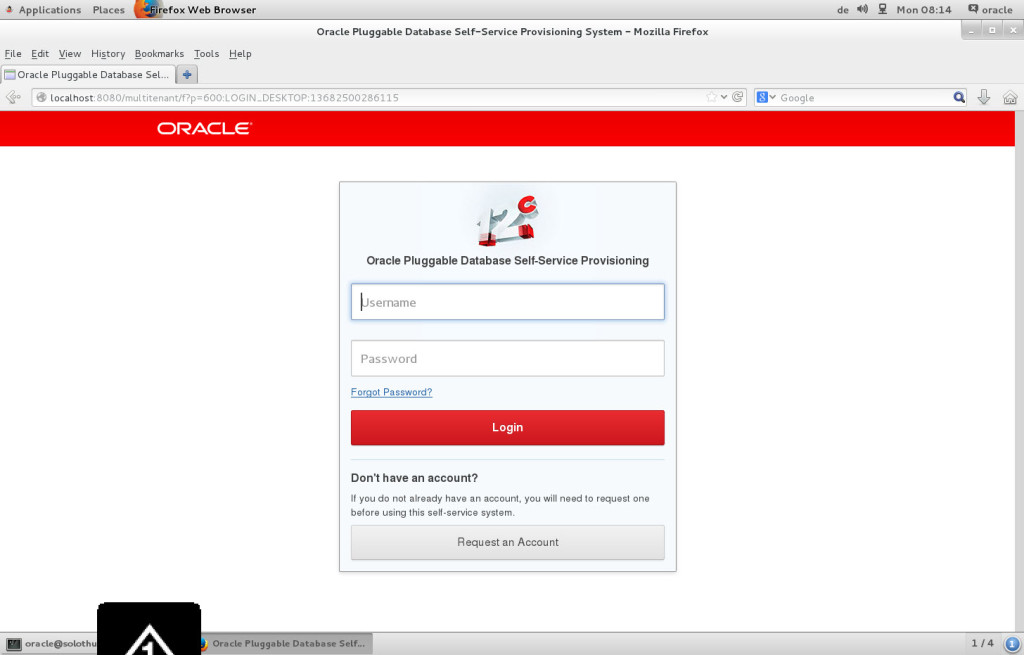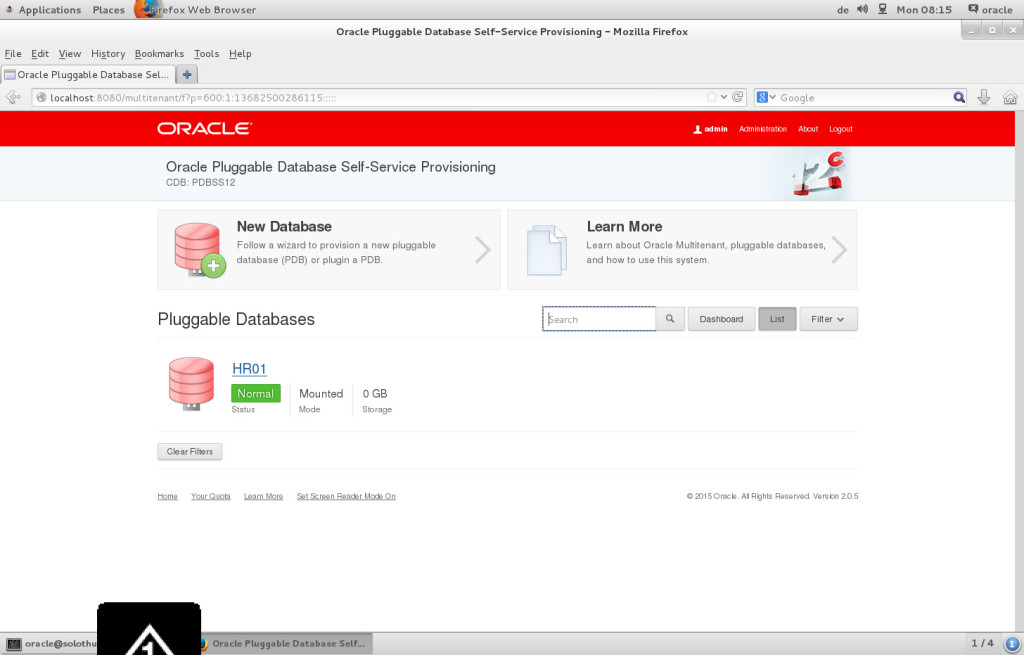Mit der Oracle Multitenant Self-Service Provisioning Applikation PDBSS hat ein DBA / Entwickler die Möglichkeit, sich mit dem mit 12c neu eingeführten Konzept von Multitenant und den Pluggable Databases (PDB) vertraut zu machen. Die auf Oracle Application Express basierende Webapplikation ist eine prima Möglichkeit, Aktionen wie Bereitstellung, cloning, plug unplug durchzuführen.
Bereits 2013 habe ich im Trivadis O-AI Blog darüber berichtet, damals war die Software noch im Beta-Status. Seit dem 20. Mai 2015 ist die finale Version als Download verfügbar. Als Neuerung wird bspw. die Apex-Applikation in CDB$ROOT installiert und der Oracle REST Data Service verwendet (vorher APEX-Listener).
Die Applikation ist nicht für den produktiven Einsatz gedacht.
Aus dem Readme:
PDBSS provides an interface to an Oracle Database 12c multitenant environment and allows for the self-service provisioning of pluggable databases (PDBs) in a multitenant container database (CDB). Its primary goal is to encourage learning about PDBs in development and test environments. It is an easy and productive way to allow database administrators (DBAs) and application developers the opportunity to gain hands-on experience with powerful PDB features, including creating PDBs, cloning PDBs, plugging in PDBs, and unplugging PDBs.
Voraussetzungen – Software
Oracle 12.1.0.2 oder höher
Oracle Application Express 4.2.5 oder höher (4.2.5 wird mit 12.1.0.2 mitgeliefert)
Oracle REST Data Services 2.0.6 oder höher (2.0.7 wird mit 12.1.0.2 mitgeliefert)
Oracle Pluggable Database Self-Service Provisioning Application
Im ZIP-Paket der Oracle Pluggable Database Self-Service Provisioning Application ist ein README.pdf mit der detaillierten Installationsanleitung verfügbar. Dabei wird auch empfohlen die neueste Version der Oracle REST Data Services herunterzuladen.
Voraussetzungen – Datenbank
Es wird eine leere Datenbank mit dem Zeichensatz AL32UTF8, sollte der lokale Listener nicht auf Port 1521 laufen, so muss in der Container-Datenbank CDB$ROOT der Parameter LOCAL_LISTENER gesetzt werden:
ALTER SYSTEM SET LOCAL_LISTENER = '(ADDRESS = (PROTOCOL=TCP)(HOST=LOCALHOST)(PORT=1522))' SCOPE = BOTH;
RESTful Web Services in der Datenbank konfigurieren
Es muss für die Datenbankbenutzer APEX_LISTENER und APEX_REST_PUBLIC_USER ein Passwort gesetzt werden. Hinweis: Die Passwörter werden später für die Konfiguration der Oracle REST Data Services benötigt.
$ cd $ORACLE_HOME/apex $ sqplus / as sysdba SQL> @apex_rest_config_con.sql PL/SQL procedure successfully completed. Enter a password for the APEX_LISTENER user [] Enter a password for the APEX_REST_PUBLIC_USER user [] Performing installation in multitenant container database in the background. The installation progress is spooled into apex_rest_config_con*.log files. Please wait... catcon: ALL catcon-related output will be written to apex_rest_config_con_catcon_18454.lst catcon: See apex_rest_config_con*.log files for output generated by scripts catcon: See apex_rest_config_con_*.lst files for spool files, if any catcon.pl: completed successfully Installation completed. Log files for each container can be found in: apex_rest_config_con*.log You can quickly scan for ORA errors or compilation errors by using a utility like grep: oracle@solothurn:/u00/app/oracle/product/12.1.0.2/apex/ [PDBSS12] grep PLS- *.log | wc -l 0 oracle@solothurn:/u00/app/oracle/product/12.1.0.2/apex/ [PDBSS12] grep ORA- *.log | wc -l 0
Unlock APEX_PUBLIC_USER und Passwort ändern
Hinweis: Das Passwort werden später für die Konfiguration der Oracle REST Data Services benötigt.
SQL> ALTER USER APEX_PUBLIC_USER IDENTIFIED BY <password> ACCOUNT UNLOCK; SQL> GRANT SET CONTAINER TO APEX_PUBLIC_USER CONTAINER=ALL; SQL> GRANT SET CONTAINER TO APEX_REST_PUBLIC_USER CONTAINER=ALL; SQL> GRANT SET CONTAINER TO APEX_LISTENER CONTAINER=ALL;
Oracle REST Data Services ORDS konfigurieren
Auf Grund von Konfigurationsproblemen habe ich auf eine aktuelle 3-er Version verzichtet und mir stattdessen die Version 2.0.10 runtergeladen und entpackt:
oracle@solothurn:/u00/app/oracle/product/ords/ [rdbms12102] ll total 55796 drwxr-xr-x. 4 oracle oinstall 4096 Jun 1 09:22 . drwxr-xr-x. 4 oracle oinstall 4096 Jun 1 09:21 .. drwxr-xr-x. 2 oracle oinstall 4096 Oct 16 2014 docs drwxr-xr-x. 4 oracle oinstall 4096 Oct 16 2014 javadoc -rw-r--r--. 1 oracle oinstall 28596908 May 23 13:53 ords.2.0.10.289.08.09.zip -rw-r--r--. 1 oracle oinstall 28491706 Oct 16 2014 ords.war -rw-r--r--. 1 oracle oinstall 24699 Oct 16 2014 readme.html
Erster Start vom ORDS
Beim ersten Start vom APEX Listener werden folgende Abfragen gemacht – diese werden dann in der Konfigurationsdatei gespeichert:
- Pfad für die Konfiguationsdatei – bspw. /u00/app/oracle/product/ords/config
- Hostname
- Port
- Datenbank-Servicename
- Passwort APEX_PUBLIC_USER
- Passwörter APEX_REST_PUBLIC_USER / APEX_LISTENER
Hinweis: Die Konfiguration vom ORDS-Benutzer muss übersprungen werden (Known Issues) – der Listener wird beim ersten Mal nicht gestartet: exit [2] am Schluss.
oracle@solothurn:/u00/app/oracle/product/ords/ [rdbms12102] java -jar ords.war This Oracle REST Data Services instance has not yet been configured. Please complete the following prompts Enter the location to store configuration data:/u00/app/oracle/product/ords/config Jun 01, 2015 9:23:15 AM oracle.dbtools.common.config.cmds.ConfigDir execute INFO: Set config.dir to /u00/app/oracle/product/ords/config in: /u00/app/oracle/product/ords/ords.war Jun 01, 2015 9:23:16 AM oracle.dbtools.common.config.file.ConfigurationFolder logConfigFolder INFO: Using configuration folder: /u00/app/oracle/product/ords/config/ords Enter the name of the database server [localhost]:solothurn Enter the database listen port [1521]: Enter 1 to specify the database service name, or 2 to specify the database SID [1]: Enter the database service name:PDBSS12.trivadis.com Enter the database user name [APEX_PUBLIC_USER]: Enter the database password for APEX_PUBLIC_USER: Confirm password: Enter 1 to enter passwords for the RESTful Services database users (APEX_LISTENER,APEX_REST_PUBLIC_USER), 2 to use the same password as used for APEX_PUBLIC_USER or, 3 to skip this step [1]: Enter the database password for APEX_LISTENER: Confirm password: Enter the database password for APEX_REST_PUBLIC_USER: Confirm password: Jun 01, 2015 9:24:08 AM oracle.dbtools.common.config.file.ConfigurationFiles update INFO: Updated configurations: defaults, apex, apex_al, apex_rt Enter 1 if you wish to start in standalone mode or 2 to exit [1]:2
Konfiguration vom DB-Suffix für ORDS
Die DB-Domain in die ORDS-Konfiguration eingetragen – Beispiel: trivadis.com. Ermitteln der DB-Domain als SYSDBA:
SQL> show parameter DB_DOMAIN NAME TYPE VALUE ------------------------------------ ----------- ------------------------------ db_domain string trivadis.com
Danach wird die Domain in ein Konfigurationsfile eingtragen welches anschliessend verwendet wird.
# echo db.serviceNameSuffix=.trivadis.com > snsuffix.properties
ORDS Konfiguration aktualisieren
oracle@solothurn:/u00/app/oracle/product/ords/ [rdbms12102] java -jar ords.war set-properties --conf apex snsuffix.properties Jun 01, 2015 7:52:15 AM oracle.dbtools.common.config.file.ConfigurationFolder logConfigFolder INFO: Using configuration folder: /u00/app/oracle/product/ords/config/ords Jun 01, 2015 7:52:15 AM oracle.dbtools.rt.config.setup.SetProperties execute INFO: Modified: /u00/app/oracle/product/ords/config/ords/conf/apex.xml, updated properties: db.serviceNameSuffix
Starten vom ORDS
Beim ersten Start wird nach dem /images Pfad gefragt – hier muss der Pfad vom $ORACLE_HOME/apex/images angegeben werden.Sollte Oracle Application Express in einem anderen Pfad installiert worden sein, so muss das entsprechende Verzeichnis angegeben werden.
oracle@solothurn:/u00/app/oracle/product/ords/ [rdbms12102] java -jar ords.war standalone --context-path /multitenant Jun 01, 2015 7:57:32 AM oracle.dbtools.common.config.file.ConfigurationFolder logConfigFolder INFO: Using configuration folder: /u00/app/oracle/product/ords/config/ords Enter the APEX static resources location or Enter to skip:/u00/app/oracle/product/12.1.0.2/apex/images Enter the HTTP port [8080]: Jun 01, 2015 7:57:55 AM oracle.dbtools.standalone.Standalone execute INFO: NOTE: Standalone mode is designed for use in development and test environments. It is not supported for use in production environments. Jun 01, 2015 7:57:55 AM oracle.dbtools.standalone.Standalone execute INFO: Starting standalone Web Container in: /u00/app/oracle/product/ords/config/ords Jun 01, 2015 7:57:55 AM oracle.dbtools.standalone.Deployer deploy INFO: Will deploy application path = /u00/app/oracle/product/ords/config/ords/ords/WEB-INF/web.xml Jun 01, 2015 7:57:56 AM oracle.dbtools.standalone.Deployer deploy INFO: Deployed application path = /u00/app/oracle/product/ords/config/ords/ords/WEB-INF/web.xml Jun 01, 2015 7:57:56 AM oracle.dbtools.common.config.file.ConfigurationFolder logConfigFolder INFO: Using configuration folder: /u00/app/oracle/product/ords/config/ords Configuration properties for: apex cache.caching=false cache.directory=/tmp/apex/cache cache.duration=days cache.expiration=7 cache.maxEntries=500 cache.monitorInterval=60 cache.procedureNameList= cache.type=lru db.hostname=solothurn db.password=****** db.port=1521 db.servicename=PDBSS12.trivadis.com debug.debugger=false debug.printDebugToScreen=false error.keepErrorMessages=true error.maxEntries=50 jdbc.DriverType=thin jdbc.InactivityTimeout=1800 jdbc.InitialLimit=3 jdbc.MaxConnectionReuseCount=1000 jdbc.MaxLimit=10 jdbc.MaxStatementsLimit=10 jdbc.MinLimit=1 jdbc.statementTimeout=900 log.logging=false log.maxEntries=50 misc.compress= misc.defaultPage=apex security.disableDefaultExclusionList=false security.maxEntries=2000 db.serviceNameSuffix=.trivadis.com db.username=APEX_PUBLIC_USER Jun 01, 2015 7:57:56 AM oracle.dbtools.common.config.db.ConfigurationValues intValue WARNING: *** jdbc.MaxLimit in configuration apex is using a value of 10, this setting may not be sized adequately for a production environment *** Jun 01, 2015 7:57:56 AM oracle.dbtools.common.config.db.ConfigurationValues intValue WARNING: *** jdbc.InitialLimit in configuration apex is using a value of 3, this setting may not be sized adequately for a production environment *** Using JDBC driver: Oracle JDBC driver version: 11.2.0.3.0 Jun 01, 2015 7:57:57 AM oracle.dbtools.rt.web.SCListener contextInitialized INFO: Oracle REST Data Services initialized Oracle REST Data Services version : 2.0.10.289.08.09 Oracle REST Data Services server info: Grizzly/1.9.49 Jun 01, 2015 7:57:57 AM com.sun.grizzly.Controller logVersion INFO: GRIZZLY0001: Starting Grizzly Framework 1.9.49 - 6/1/15 7:57 AM Jun 01, 2015 7:57:57 AM oracle.dbtools.standalone.Standalone execute INFO: http://localhost:8080/multitenant/ started.
Mit der URL http://localhost:8080/multitenant/ erreicht man die Oracle Application Express Startseite:
Installation der PDBSS-Applikation
Die Applikation habe ich auf dem Server in ein temporäres Verzeichnis entpackt, welches später dann gelöscht werden kann. Die Installation erfolgt mit einem SQL-Script aus dem entpackten Unterverzeichnis pdbss, welches als SYSDBA in der Container-Datenbank CDB$ROOT ausgeführt wird:
oracle@solothurn:/u00/app/oracle/tmp/ [rdbms12102] ll total 604 drwxr-xr-x. 3 oracle oinstall 4096 Jun 1 08:05 . drwxr-xr-x. 14 oracle dba 4096 Jun 1 08:04 .. -rw-r--r--. 1 oracle oinstall 176954 May 8 16:45 README.pdf drwxr-xr-x. 3 oracle oinstall 4096 Apr 28 18:10 pdbss -rw-r--r--. 1 oracle oinstall 425183 May 21 12:12 pdbss_2.0.5.zip
Das Script pdbss_ins.sql wird als SYSDBA gestartet. Die Frage nach dem Demonstration Mode, Datafiles und Port kann mit Enter beantwortet werden. Der neu angelegte ADMIN User ist dann der Verwalter der PDBSS-Applikation. Die Installation ist in kurzer Zeit durch.
SQL> @pdbss_ins.sql . ... Prerequisite checks passed. . Allow demonstration mode [no]: Enter destination for PDB data files [/u01/oradata/PDBSS12]: Enter the port used to access this database [1521]: Enter a password for the self-service ADMIN user: .. timing for: Complete Install Elapsed: 00:01:53.18 . . Done. Please review pdbss_ins.log for any errors. .
Login in die Oracle Multitenant Self-Service Provisioning Applikation
Die URL muss mit dem Suffix f?p=pdbss ergänz werden:http://localhost:8080/multitenant/f?p=pdbss – danach erscheint die Startseite und es kann sich eingeloggt werden. Der Benutzer heisst ADMIN, das Passwort wurde bei der Installation mit dem pdbss_ins.sql gesetzt.
ORDS Service separat starten
Der Service läuft aktuell als Terminal-Job. Das heisst sobald das Terminalfenster zu ist, ist kein Zugriff mehr auf die Applikation möglich. Verschiedene Lösungen sind möglich:
- ORDS Service starten als nohup &
- Verwenden eines Start/Stop Scripts aus dem Netz mit den Anpassungen für ORDS, bspw. das APEX Startup- / Shutdown-Script von Kris Rice
#!/bin/sh
#
. /etc/rc.d/init.d/functions
NAME="Oracle REST Data Services"
JAVA="/usr/bin/java"
ORDSWAR="/u00/app/oracle/product/ords/ords.war"
OPTIONS="-Xmx1024m -Xms256m -jar $ORDSWAR"
LOGFILE=/tmp/ords_listener.log
PIDFILE=/tmp/ords_listener.pid
start() {
echo -n "Starting $NAME: "
if [ -f $PIDFILE ]; then
PID=`cat $PIDFILE`
echo ORDS already running: $PID
exit 2;
else
nohup $JAVA $OPTIONS 2>&1 > $LOGFILE &
RETVAL=$!
echo Started PID: $RETVAL
echo
echo $RETVAL >>$PIDFILE
return $RETVAL
fi
}
status() {
echo -n "Status $NAME: "
if [ -f $PIDFILE ]; then
PID=`cat $PIDFILE`
echo ORDS already running: $PID
ps -ef | grep $PID
else
echo ORDS Listener not running
fi
}
stop() {
if [ -f $PIDFILE ]; then
PID=`cat $PIDFILE`
echo -n "Shutting down $NAME "
echo
kill $PID
rm -f $PIDFILE
else
echo ORDS not running
fi
return 0
}
log() {
tail -f $LOGFILE
}
case "$1" in
start)
start
;;
stop)
stop
;;
status)
status
;;
restart)
stop
start
;;
log)
log
;;
*)
echo "Usage: {start|stop|status|restart|log}"
exit 1
;;
esac
exit $?
Fazit
Die Oracle Multitenant Self-Service Provisioning Applikation hat den Beta-Status überwunden und ist nun offiziell verfügbar. Gerade für DBAs und Entwickler bietet die Apex-Applikation eine tolle Gelegenheit, sich mit Multitenant auseinanderzusetzen. Das Verständnis für die neue Architektur ist wichtig und gehört zu den technischen Grundlagen beim zukünftigen Einsatz von Oracle 12c.



